Materials are constantly in motion on our campus.
Paper products, food, packaging, merchandise, clothing, furniture: much of it flows in and out of our lives in a convenient unidirectional cycle. However, the endpoint of this single direction flow is often the landfill – and much of that material, culturally accepted as waste, could have been diverted in a variety of ways. Read more about how St. Olaf works to address responsibly this cultural facet of daily life at both an institutional and individual level.
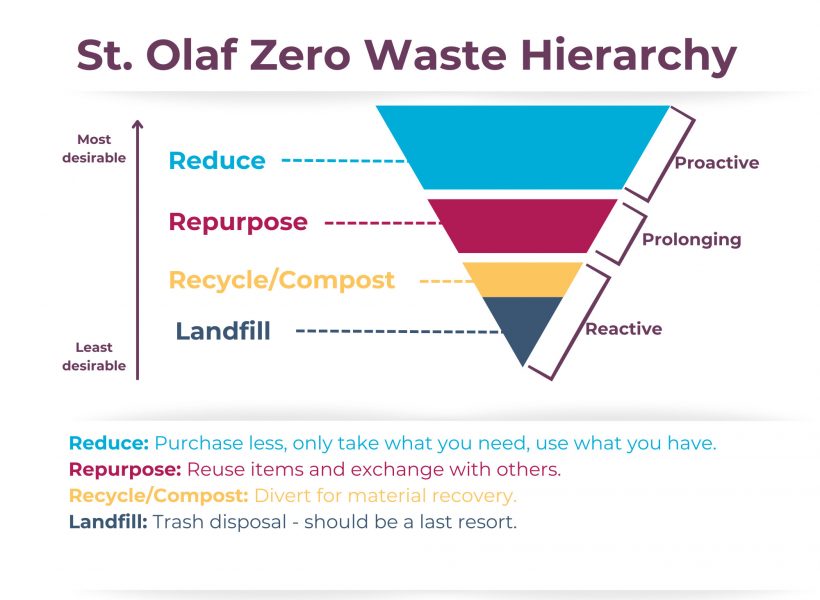
Moving Towards Zero Waste
The Zero Waste International Alliance developed what is called a Zero Waste Hierarchy, a series of possible next steps for an item that no longer serves its initial purpose. This hierarchy is used widely by many institutions to demonstrate desirable alternatives to landfill disposal. To the right is a St. Olaf-specific chart designed to simplify the hierarchy and make the steps fully applicable to our campus’ material flow. Read more about St. Olaf’s actualization of each section of the hierarchy below.
initiatives to reduce waste
- The student-led Take Back the Tap initiative established in 2013 by the student organization Environmental Coalition worked to reduce the use of plastic water bottles, and some of those changes are still in place today. Most notable among these are the water bottle refilling stations located throughout campus buildings, encouraging students to use their own reusable water bottle instead of buying disposable plastic ones.
- In February of 2023, Bon Appétit introduced UsefullTM reusable to-go containers for students wishing to eat outside of the cafeteria. These replaced the previous to-go containers, which were compostable but still created large volumes of waste.
- The Cage café will use a student’s mug for drip coffee if they bring their own (and you get a free cup of coffee when you do this 8 times!)
- Many courses offer PDFs and online textbooks so students don’t have to buy the physical copies.
InitiativeS to repurpose materials
The student-led organization Ole Thrift Shop collects unwanted clothing and dorm items at the end of the year and resells them to students during the year to keep unwanted clothing from going directly to the landfill. This encourages a more cyclical understanding of materialism and helps students contribute back to the campus community.
Food Recovery Network has a small group of students repurpose leftover food from the cafeteria at the end of the day and delivers it to local organizations that make sure it gets to people in need.
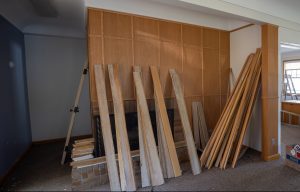
During deconstruction projects, our construction team repurposes a lot of the usable building materials, and also lets salvage companies take what they can before sending the deconstruction waste to the landfill. This includes everything from trim to light fixtures.
- The chalkboards in Regents Hall were salvaged from Flaten Hall, the building that used to stand where Regents is now. The construction team designed the walls specifically so the boards would fit.
- A previous college carpenter, Gregg Menning, created our iconic yellow Adirondack chairs from the old wooden Skoglund bleachers.
The post office collects pre-used packaging and allows students to use those materials to safely mail their own packages.
You can find ‘free tables’ all over campus, especially in academic buildings, where people are free to take books and other unwanted items that others have left.
The previous campus fleet of vans was transferred to the Facilities team when new vans were purchased, preventing the unnecessary purchase of new vehicles for facilities work.
recycling bins
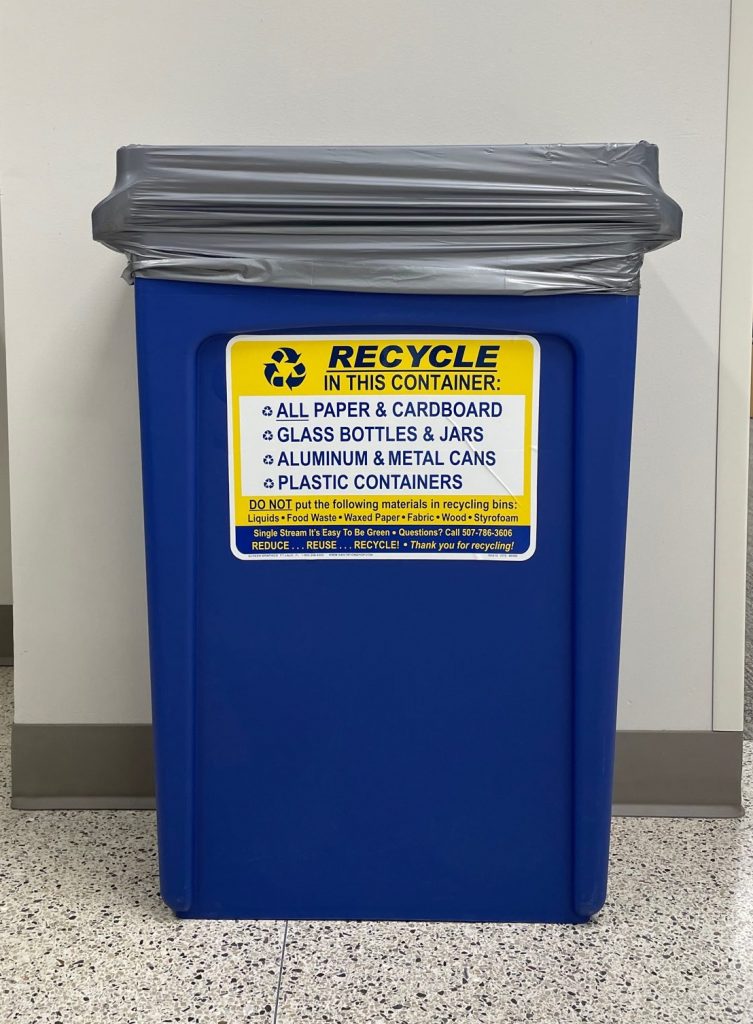
Recycling bins are provided for each student room and are present in every office or department on campus. Bins are also provided in high-traffic or high-use areas and for special events. The bins are labeled clearly with instructions on what can and cannot be recycled, and are clearly recognizable by their blue color.
recycled material
Ninety-five percent of all paper used on campus is made from recycled content, and 90 percent of the paper products used by Bon Appétit, the St. Olaf food service provider, are made from recycled content.
If you have electronics you no longer want, find an e-cycling location rather than throwing it away. Rice County has a comprehensive list of e-cycling locations on their recycling center website.
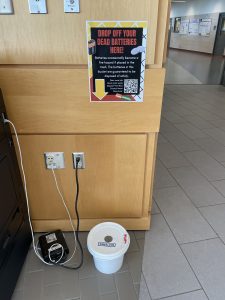 If you have batteries to recycle, place them in the battery bucket rather than the blue co-mingled collection bins! Even though they are made of metal, a material that is typically recycled, the chemicals within batteries easily cause fires in the Material Recovery Facilities and are an extremely hazardous item for the workers. Instead, recycle your batteries in the battery recycle bucket found on the second floor of Regents Hall in the atrium, right next to the printer.
If you have batteries to recycle, place them in the battery bucket rather than the blue co-mingled collection bins! Even though they are made of metal, a material that is typically recycled, the chemicals within batteries easily cause fires in the Material Recovery Facilities and are an extremely hazardous item for the workers. Instead, recycle your batteries in the battery recycle bucket found on the second floor of Regents Hall in the atrium, right next to the printer.
collection, transportation, and sorting
The college’s recycling program is directly tied to Rice County’s co-mingled system. This means that essentially all recyclable materials can be collected in the same bin, picked up in the same truck, and delivered to the same facility. Additionally, the responsibility of correct material sorting happens off campus rather than falling to individual students, faculty, staff, and guests, increasing its accuracy. Co-mingled recycling collection also leads to higher participation rates than that of a more material-specific collection system.
Waste Management Inc. collects all recycled materials from on-campus facilities zoned as private college land and transports it to the Dem-Con Materials Recovery Facility in Shakopee. Dick’s Sanitation collects single-sort recycling from all St. Olaf owned land within residential and neighborhood zoning lines and transports it to the Recycle Minnesota Materials Recovery Facility in Lakeville.
Watch this video made by Dem-Con to get a sense of where your recycling goes once you toss it in the bin, and to become familiar what our sorting site does NOT accept.
Compost bins
Currently only compost from Buntrock Commons is being collected. Compost bins have green compostable bags inside of them. Bins that are actively being composted are located next to the Usefull bowl container return stations and in the triple waste collection block across from the Cage.
bon appétit
Bon Appétit composts 100% of its food scraps, including the Cafeteria, the Cage, the King’s Dining Room, and all catered events. Learn more here.
collection and transportation
All organic waste collected on campus is gathered in a compost receptacle in the basement of Buntrock Commons. From there, Waste Management Inc. collects it and transports it to SET-Empire (formerly known as the Mulch Store) in Rosemount, MN, where the compost is transformed into sellable landscaping products.
Garbage bins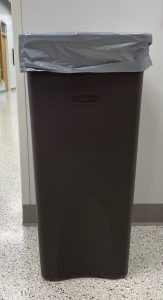
Garbage bins are present in every office, department, and hallway on campus. Bins are also provided in high-traffic or high-use areas and for special events. The bins are gray and are often labeled as trash.
collection and transportation
The waste collected by Dick’s Sanitation (neighborhood and residential City of Northfield zones) and Waste Management (private college zones) is hauled to the Rice County Landfill. The landfill is responsible for ensuring that all waste is disposed of in an environmentally sound manner. The final cell for disposal is being filled at this site; consequently, there is a very finite lifetime remaining for this site to accept wastes, which is why landfill disposal is at the bottom of this zero waste hierarchy. The less we can throw away, the better.
You must be logged in to post a comment.